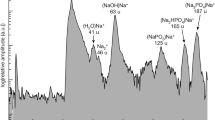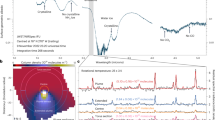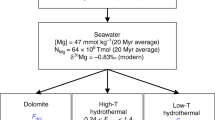Abstract
Saturn's moon Enceladus emits plumes of water vapour and ice particles from fractures near its south pole1,2,3,4,5, suggesting the possibility of a subsurface ocean5,6,7. These plume particles are the dominant source of Saturn’s E ring7,8. A previous in situ analysis9 of these particles concluded that the minor organic or siliceous components, identified in many ice grains, could be evidence for interaction between Enceladus’ rocky core and liquid water9,10. It was not clear, however, whether the liquid is still present today or whether it has frozen. Here we report the identification of a population of E-ring grains that are rich in sodium salts (∼0.5–2% by mass), which can arise only if the plumes originate from liquid water. The abundance of various salt components in these particles, as well as the inferred basic pH, exhibit a compelling similarity to the predicted composition of a subsurface Enceladus ocean in contact with its rock core11. The plume vapour is expected to be free of atomic sodium. Thus, the absence of sodium from optical spectra12 is in good agreement with our results. In the E ring the upper limit for spectroscopy12 is insufficiently sensitive to detect the concentrations we found.
This is a preview of subscription content, access via your institution
Access options
Subscribe to this journal
Receive 51 print issues and online access
$199.00 per year
only $3.90 per issue
Buy this article
- Purchase on Springer Link
- Instant access to full article PDF
Prices may be subject to local taxes which are calculated during checkout




Similar content being viewed by others
References
Dougherty, M. K. et al. Identification of a dynamic atmosphere at Enceladus with the Cassini magnetometer. Science 311, 1406–1409 (2006)
Hansen, C. J. et al. Enceladus' water vapor plume. Science 311, 1422–1425 (2006)
Spahn, F. et al. Cassini dust measurements at Enceladus and implications for the origin of the E ring. Science 311, 1416–1418 (2006)
Waite, J. H. et al. Cassini ion and neutral mass spectrometer: Enceladus plume composition and structure. Science 311, 1419–1422 (2006)
Porco, C. C. et al. Cassini observes the active south pole of Enceladus. Science 311, 1393–1401 (2006)
Spencer, J. R. et al. Cassini encounters Enceladus: background and the discovery of a south polar hot spot. Science 311, 1401–1405 (2006)
Schmidt, J., Brilliantov, N., Spahn, F. & Kempf, S. Slow dust in Enceladus' plume from condensation and wall collisions in tiger stripe fractures. Nature 451, 685–688 (2008)
Kempf, S. et al. The E ring in the vicinity of Enceladus. I. Spatial distribution and properties of the ring particles. Icarus 193, 420–437 (2008)
Postberg, F. et al. The E ring in the vicinity of Enceladus. II. Probing the moon’s interior—the composition of E-ring particles. Icarus 193, 438–454 (2008)
Matson, D. L., Castillo, J. C., Lunine, J. & Johnson, T. V. Enceladus’ plume: compositional evidence for a hot interior. Icarus 187, 569–573 (2007)
Zolotov, M. Y. An oceanic composition on early and today’s Enceladus. Geophys. Res. Lett. 34, L23203 (2007)
Schneider, N. M. et al. No sodium in the vapour plumes of Enceladus. Nature 10.1038/nature08070 (this issue)
Srama, R. et al. The Cassini cosmic dust analyzer. Space Sci. Rev. 114, 465–518 (2004)
Hillier, J. K. et al. The composition of Saturn's E ring. Mon. Not. R. Astron. Soc. 388, 1588–1596 (2007)
Nimmo, F., Spencer, J. R., Papparlado, R. T. & Mullen, M. E. Shear heating as the origin of the plumes and heat flux on Enceladus. Nature 447, 289–291 (2007)
Kieffer, S. W. et al. A clathrate reservoir hypothesis for Enceladus' south polar plume. Science 314, 1764–1766 (2006)
Steinbach, C. & Buck, U. Reaction and solvation of sodium in hydrogen bonded solvent clusters. Phys. Chem. Chem. Phys. 7, 986–990 (2005)
Postberg, F. et al. Discriminating contamination from particle components in spectra of Cassini’s dust detector CDA. Planet. Space Sci. (in the press)
Charvat, A. & Abel, B. How to make big molecules fly out of liquid water: applications, features and physics of laser assisted liquid phase dispersion mass spectrometry. Phys. Chem. Chem. Phys. 9, 3335–3360 (2007)
Frohn, A. & Roth, N. Dynamics of Droplets 245–260 (Springer, 2000)
Harder, H. Über das Kalium-Natrium-Verhältnis in Gewässern und die Tonmineralbildung. Naturwissenschaften 54, 613 (1967)
Kempe, S. & Kazmierczak, J. Biogenesis and early life on Earth and Europa: favoured by an alkaline ocean? Astrobiology 2, 123–130 (2002)
McKay, C. P., Porco, C. C., Altheide, T., Davis, W. L. & Kral, T. A. The possible origin and persistence of life on Enceladus and detection of biomarkers in the plume. Astrobiology 8, 909–919 (2008)
Spitale, J. N. & Porco, C. C. Association of jets on Enceladus with the warmest regions on its south-polar fractures. Nature 449, 695–697 (2007)
Dzidic, I. & Kebarle, P. Hydration of the alkali ions in the gas phase. J. Phys. Chem. 74, 1466–1474 (1969)
Schulz, C. P., Haugstätter, R., Tittes, H. U. & Hertel, I. V. Free sodium-water clusters. Phys. Rev. Lett. 57, 1703–1706 (1986)
Buck, U. & Steinbach, C. Formation of sodium hydroxide in multiple sodium-water cluster collisions. J. Phys. Chem. A 102, 7333–7336 (1998)
Kempf, S., Beckmann, U. & Schmidt, J. How the Enceladus dust plumes form Saturn’s E ring. Icarus (submitted)
Acknowledgements
We thank U. Beckmann, M. Burger, M. Burton, M. Gellert, E. Grün, J. K. Hillier, N. Schneider, F. Spahn, and M. Zolotov for discussions. We acknowledge the efforts of the Cassini team and JPL. The work has been supported by the DLR, the DFG and the Frontier programme of the University of Heidelberg.
Author information
Authors and Affiliations
Corresponding author
Supplementary information
Supplementary Information
This file contains Supplementary Methods and Data, Supplementary Notes, Supplementary Table S1, Supplementary Figures S1-S4 with Legends and Supplementary References. (PDF 1011 kb)
Rights and permissions
About this article
Cite this article
Postberg, F., Kempf, S., Schmidt, J. et al. Sodium salts in E-ring ice grains from an ocean below the surface of Enceladus. Nature 459, 1098–1101 (2009). https://doi.org/10.1038/nature08046
Received:
Accepted:
Issue Date:
DOI: https://doi.org/10.1038/nature08046
This article is cited by
-
MASPEX-Europa: The Europa Clipper Neutral Gas Mass Spectrometer Investigation
Space Science Reviews (2024)
-
Detection of phosphates originating from Enceladus’s ocean
Nature (2023)
-
Particle entrainment and rotating convection in Enceladus’ ocean
Communications Earth & Environment (2023)
-
Detection of HCN and diverse redox chemistry in the plume of Enceladus
Nature Astronomy (2023)
-
Phosphate availability and implications for life on ocean worlds
Nature Communications (2023)
Comments
By submitting a comment you agree to abide by our Terms and Community Guidelines. If you find something abusive or that does not comply with our terms or guidelines please flag it as inappropriate.



